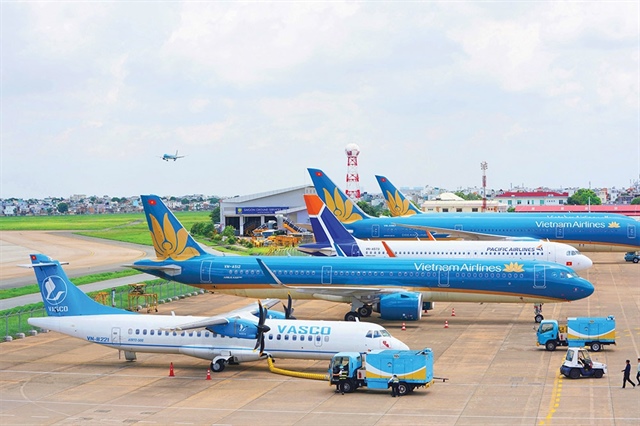Vietnam’s airlines seek more upward financial progress
Vietnam’s airlines seek more upward financial progress
Air carriers in Vietnam escaped losses in the first months of 2025, driven by global expansion and strategic changes.
According to the Civil Aviation Authority of Vietnam, air transport in the first three months of 2025 recovered beyond 2019 levels, reaching more than 20.7 million passengers, up 9.2 per cent on-year. Freight transport also grew strongly with 329,000 tonnes, up 12.4 per cent over the same period last year.
Aviation expert Tuan Nguyen said, “This was a positive result in the context that the fleet of domestic airlines has not been supplemented in time due to the prolonged impact of the global supply chain after the COVID-19 pandemic.”

Vietnam Airlines, Vietjet, and others are continually looking to increase route numbers, photo Le Toan |
Vietnam Airlines reported consolidated pre-tax profits estimated at nearly VND3.62 trillion ($144.8 million) between January and March thanks to the strong recovery of the international passenger market, favourable developments in fuel prices, and a flexible operating strategy.
In the period, the airline welcomed over six million passengers, up 6.5 per cent on-year. Travellers mostly came from India, the Middle East, Northeast Asia, and China.
The company’s net revenue and profit after tax reached $1.22 billion and nearly $140 million, respectively. Although net revenue increased by 8.34 per cent over the same period last year, its profit after tax decreased by 21.5 per cent due to a 14.9 per cent increase in selling expenses and a 2.4 per cent hike in administrative expenses.
Vietnam Airlines has focused on maintaining a stable domestic flight network, optimising resources during the international peak period, and chartering additional aircraft for peak periods.
In the international market, the group has opened and resumed many key routes, put into operation Boeing 787-9 aircraft. It also utilised the operation of the Tan Son Nhat T3 terminal and applied biometric identification using VNeID.
Vietnam Airlines’ current focus is on negotiating with creditors to restructure loans, finding strategic partners to increase charter capital, and restructuring business operations to improve the efficiency of fleet and route network operations.
The airline expects to escape accumulated losses in the 2025-2026 period, assuming stable growth in the aviation market and no strong fluctuations in fuel prices.
Recent months were also strong for budget carrier Vietjet, with consolidated revenue and pre-tax profit increasing by 24 per cent on-year to $718 million and $33.44 million, respectively.
The airline transported more than 6.87 million passengers on nearly 38,700 flights, up 9 and 12 per cent, respectively, over the same period in 2024. It operates almost 140 routes, including nearly 100 international routes.
During the period, the airline received two new aircraft, bringing its total fleet to 106. It launched four routes connecting Hanoi and Ho Chi Minh City with Beijing and Guangzhou, and two others connecting Ho Chi Minh City with Bengaluru and Hyderabad in India, enabling it to connect more deeply with those massive markets.
In addition, the airline announced two direct flights from Phu Quoc to Singapore and Ho Chi Minh City to Auckland in New Zealand, expected to open this year. Vietjet is also expanding international cooperation, including with US partners like Boeing, GE, CFM, Pratt & Whitney, and Honeywell.
Deputy Minister of Construction Le Anh Tuan said that 2025 marks a transformative year for the aviation industry. “In the second quarter, we need to focus on building the amended Law on Civil Aviation of Vietnam, administrative reform, and putting the Long Thanh International Airport into operation on time,” Tuan said.
Expert Tuan Nguyen explained that aviation businesses are still facing major challenges. Regarding capital structure, Vietjet’s liabilities accounted for 83 per cent, higher than its equity. Short-term assets reached $1.69 billion, up 3.82 per cent on-year, but the proportion in total assets decreased to 42.6 per cent.
The airline’s lending interest expenses are still high, and financial leases in 2024 also increased. However, lending rates in 2025 are expected to not increase sharply when interest rates have shown signs of decreasing, and it will not have any bonds due for principal payment this year.
“In general, Vietnam Airlines is in a positive recovery phase with optimistic signals about flight demand, ticket prices, and flexibility in financial management. However, to truly escape losses, it still needs more time and especially macroeconomic stability and a sustainable restructuring strategy,” Nguyen said.
Vietnam Airlines, Vietjet, and Airports Corporation of Vietnam are making plans to increase charter capital. Vietnam Airlines plans to increase charter capital by $880 million to $1.76 billion; while Vietjet will have its charter capital increased to over $236 million.
According to forecasts from the International Air Transport Association, the Asia-Pacific region continues to be one of the fastest-growing aviation markets in the world. The average growth rate of Vietnam’s aviation market is estimated at 5-6 per cent per year, bringing the total market size to about 150 million passengers by 2035, nearly double that of 2019.
- 15:41 22/05/2025























